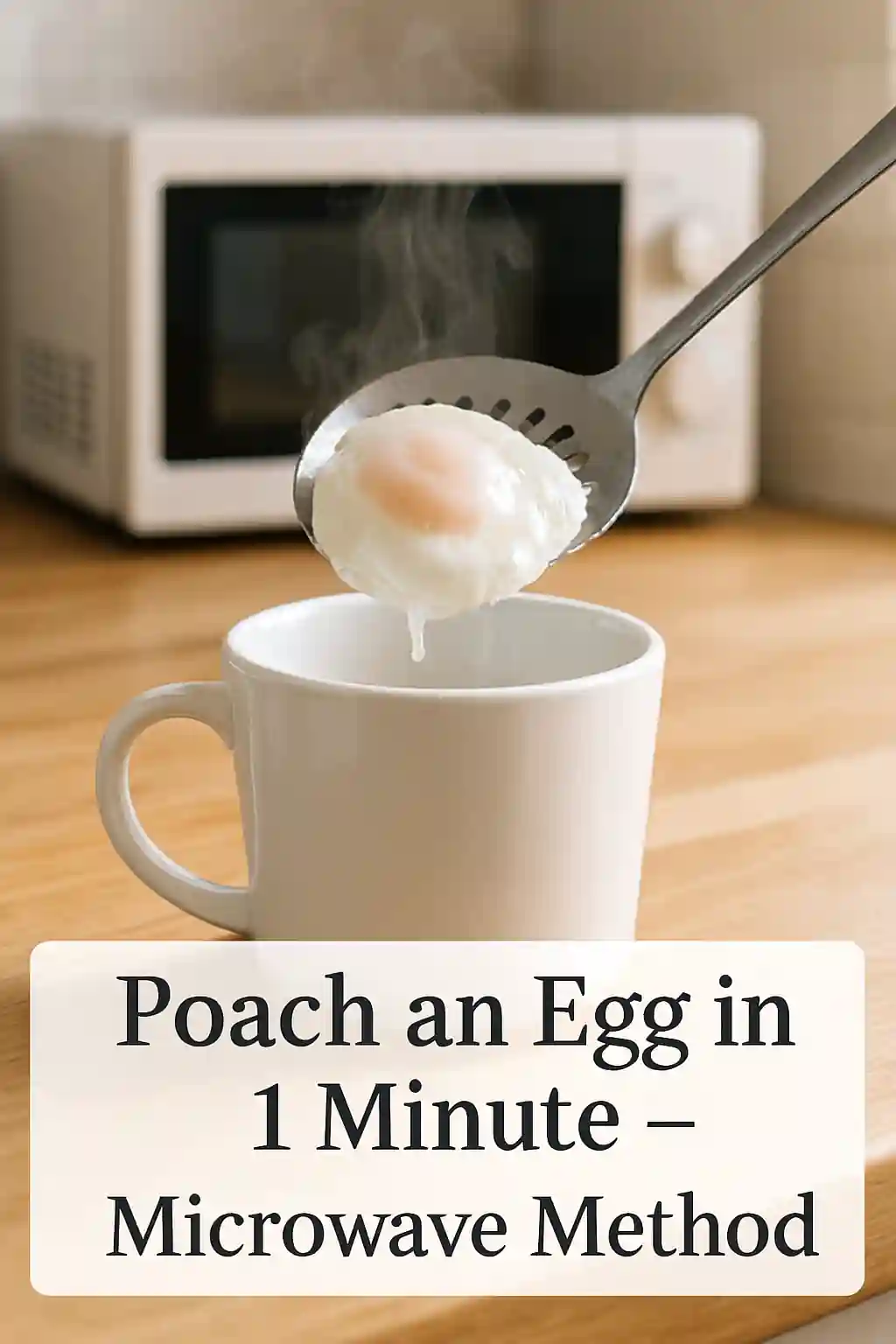How to Poach an Egg in the Microwave
Poaching an egg in the microwave might seem intimidating at first, especially if you’ve grown up believing that the only way to poach eggs is with simmering water and precise timing on a stovetop. But in reality, a microwave poached egg can be just as delicious, just as runny or firm, and far more convenient—especially for those short on time. Whether you want an easy breakfast, a topping for toast, or a protein-packed addition to your ramen, knowing how to poach an egg in the microwave is a valuable kitchen skill.
This guide will take you through everything you need to know about making perfect poached eggs in a microwave, from selecting the right egg and container to avoiding exploding yolks. We’ll also compare microwave poaching to traditional methods, explore different microwave models, and offer tips for getting consistently excellent results.
Why Poach an Egg in the Microwave?
Microwave cooking has transformed the modern kitchen. It’s quick, efficient, and minimizes cleanup. Poaching eggs the traditional way—by simmering water in a saucepan—can take 10 to 15 minutes and requires constant attention. In contrast, microwave-poached eggs take as little as 1 minute and require just a cup of water, a mug or bowl, and an egg.
Here are a few reasons to poach an egg using a microwave:
-
Speed: Perfectly poached in about 1 minute.
-
Convenience: Minimal equipment and dishes.
-
Control: Easy to adjust the cook time for different yolk textures.
-
Accessibility: Great for college students, office kitchens, or hotel stays.
What You Need to Microwave Poach an Egg
Before diving into the method, let’s review the essential tools and ingredients.
Equipment:
-
Microwave oven
-
Microwave-safe mug or bowl (ceramic or glass)
-
Microwave egg poacher (optional but helpful)
-
Slotted spoon
-
Toothpick or fork (for pricking the yolk)
-
Plastic wrap or microwave-safe plate (for covering)
Ingredients:
-
1 fresh egg (the freshest eggs you can find are ideal)
-
½ cup to 1 cup of water
-
A splash of vinegar (optional, helps the egg white hold shape)
-
Salt and pepper or other seasonings
Step-by-Step: How to Make a Microwave Poached Egg
Step 1: Use the Freshest Egg You Can Find
For the best results, always use fresh eggs. The older the egg, the more likely it is to disperse in the water, making it harder to form that tight, round shape you want in a perfect poached egg.
Step 2: Prepare Your Mug or Bowl
Add about ½ to 1 cup of water to your microwave-safe mug or bowl. If you’re using a microwave egg poacher, follow the device’s specific instructions. Add a splash of vinegar to the water if you like—a common chef’s trick to help the egg white coagulate.
Step 3: Crack One Egg into the Water
Crack one egg into the center of the mug, ensuring the yolk remains intact. Try not to break the yolk, especially if you want that runny center.
Step 4: Prick the Yolk (Prevent Exploding Yolks)
To avoid exploding yolks, gently pierce the surface of the egg yolk with a toothpick or fork. This creates a tiny vent for steam and prevents pressure buildup. This step is critical for safety when cooking egg in the microwave.
Step 5: Cover and Microwave
Cover the mug with a microwave-safe plate or loosely with plastic wrap. Then, microwave on high for 30 to 45 seconds, depending on your watt microwave. Most microwave models range from 800W to 1200W, and the cook time varies accordingly.
If the egg needs more time, microwave in 10-second intervals until the egg white is set and the yolk is cooked to your liking.
Step 6: Transfer and Serve
Using a slotted spoon, transfer the egg from the water to a plate or directly onto toast, ramen, or salad. Add a pinch of salt and pepper.
You’ve now learned how to make a microwave poached egg in less than a minute!
Cook Times by Microwave Wattage
| Microwave Wattage | Initial Time | Additional Time if Needed |
|---|---|---|
| 700W | 45 seconds | 10–15 sec intervals |
| 1000W | 30 seconds | 5–10 sec intervals |
| 1200W | 25 seconds | 5 sec intervals |
Tip: Always adjust timing based on egg size, container material, and starting water temperature.
Avoiding Common Mistakes When Poaching Eggs in the Microwave
Exploding Yolks
Microwaves cook from the inside out, which can cause egg yolks to explode if pressure builds. Always prick the yolk before microwaving and avoid overcooking. If your egg explodes in the microwave, you may need to clean the entire inside—and no one wants that.
Overcooked Eggs
A perfect poached egg has a runny yolk and just-set white. Watch closely, especially during the final 10 seconds. Overcook, and you’ll have a hard-boiled egg instead.
Using the Wrong Container
Metal bowls or mugs with metallic rims are not microwave-safe. Stick with ceramic or glass. Using a mug helps contain the egg and makes it easier to remove.
Microwave Poached Egg vs Traditional Poaching
| Feature | Microwave Method | Traditional Method |
|---|---|---|
| Time | 30–60 seconds | 8–12 minutes |
| Cleanup | One mug | Pot, strainer, bowl |
| Yolk Control | Good, but less precise | Excellent |
| Multiple Eggs | One or two eggs at a time max | Up to 4–6 eggs with experience |
| Skill Needed | Easy to learn | Takes practice |
| Risk of Exploding | Yes, if yolk is not pricked | No |
| Ideal For | Quick breakfasts, office, hotel stays | Brunches, restaurant-quality poaching |
Microwave is best when you make one egg at a time and are short on time. For more elaborate breakfasts, simmering water and stovetop methods offer better consistency.
Can You Poach Two Eggs in a Microwave?
Yes, but there are caveats. Use a large, wide microwave-safe bowl and crack the two eggs into opposite sides. Increase water to about 1.5 cups. You’ll likely need to increase cook time to 60–75 seconds depending on your microwave and cook setting.
Avoid letting the eggs touch or overlap; otherwise, they’ll fuse together or cook unevenly.
Tips for Perfect Microwave Poached Eggs Every Time
-
Use the freshest eggs you can find.
-
Always prick the yolk to prevent explosions.
-
Cover the mug while cooking to contain splatter.
-
Add vinegar to the water to help the egg white stay together.
-
Always use a slotted spoon to remove the egg from the mug.
-
For consistent results, test your microwave on high for 30 seconds, then adjust.
-
Don’t walk away! Stay near the microwave during cooking.
-
Add the poached egg immediately to toast, salads, or noodles for best texture.
Microwave Poached Eggs in Different Dishes
Here are a few ways to incorporate your microwave-poached egg into everyday meals:
-
On Avocado Toast: Add a sprinkle of chili flakes and sea salt.
-
In Instant Ramen: Drop the poached egg in the microwave into your bowl of hot noodles.
-
Breakfast Sandwich: Layer with cheese and tomato on an English muffin.
-
Salads: A perfect poached egg makes Caesar salads heartier.
-
Rice Bowls: Add to Korean bibimbap or a veggie rice bowl.
Egg Safety and Nutritional Considerations
Eggs are a great source of high-quality protein, B vitamins, and essential fats. However, always ensure your egg in the microwave is fully cooked—particularly the egg white—to avoid any foodborne risks like Salmonella.
Avoid hard-boiling unless desired. The microwave can overcook the egg quickly, so watch carefully if you’re seeking perfectly poached or runny yolks.
Microwave Poaching for Beginners and Students
Microwave poaching is ideal for:
-
College students in dorms
-
Busy parents preparing fast meals
-
Office workers using a breakroom microwave
-
Anyone without a stovetop
Affordable microwave egg poachers can make the process easier and more consistent.
How to Poach an Egg in the Microwave in 1 Minute

Frequently Asked Questions (FAQ)
Can I microwave a poached egg without water?
No. Water is essential to evenly cook the egg and prevent explosions. Never try to microwave an egg without water unless it’s scrambled.
Why does my egg explode in the microwave?
The yolk builds up steam when not pricked, causing it to burst. To avoid exploding yolks, always prick the egg yolk with a toothpick before microwaving.
Do I need to add vinegar to poach an egg in the microwave?
It’s optional. A splash of vinegar helps the egg white coagulate more neatly but isn’t required.
How long should I cook the egg for a runny yolk?
Start with 30 seconds on high. Check if the white is set; if not, continue in 5–10 second intervals. For a perfect poached egg, you may land between 30 to 45 seconds depending on wattage.
Can I poach two eggs at once?
Yes, but be careful. Use a wider container, more water, and keep the eggs apart. Increase cooking time slightly.
What’s the difference between a microwave poached egg and a hard-boiled egg?
A poached egg has a soft white and a runny or semi-firm yolk. A hard-boiled egg is cooked fully in and out. Overcooking in the microwave can turn a poached egg into a hard-boiled one.
Can I use a microwave egg poacher?
Yes. These tools are designed for this exact process and often result in perfect microwave poached eggs every time with less guesswork.
Poaching an egg in the microwave is one of the easiest kitchen hacks you can learn. With the right prep, timing, and a few safety precautions, anyone can make a perfect poached egg in the microwave in under 1 minute. Whether you’re making a perfect poached egg for toast or trying to save time in the morning, this method is a reliable go-to for beginners and pros alike.

